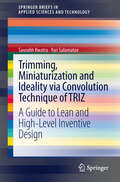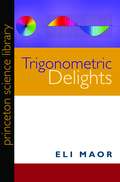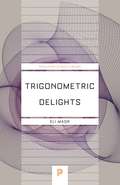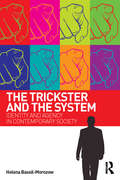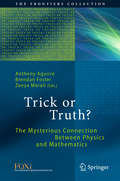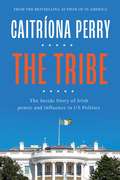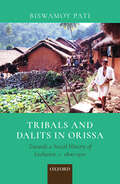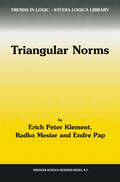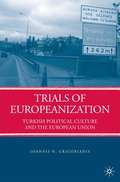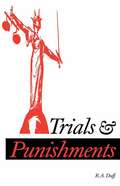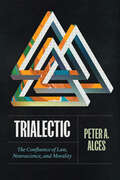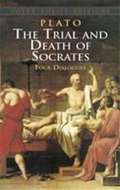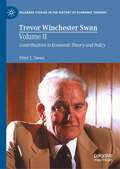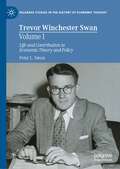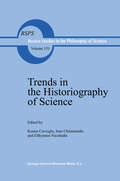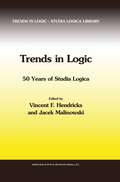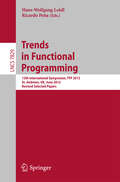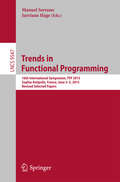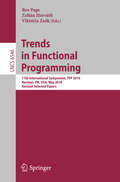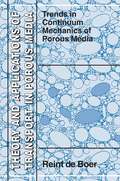- Table View
- List View
Trimming, Miniaturization and Ideality via Convolution Technique of TRIZ: A Guide to Lean and High-level Inventive Design (SpringerBriefs in Applied Sciences and Technology)
by Saurabh Kwatra Yuri SalamatovThe book is a valuable research tool-kit for innovators, amateur & professionals alike. Additionally, College & University faculties on Engineering, who organize yearly workshops internationally will find hundreds of novel themes to choose from. Some teachers might just secretly buy this book to introduce out-of-box brain-teasers in classroom to add fizz to normal (at times boring) lecturing. The book can be used as main/add-on textbook towards following courses: (1) Master's degree programs on design innovation worldwide and (2) Senior undergraduate courses in industrial, engineering & product design.
Trigonometric Delights
by Eli MaorTrigonometry has always been an underappreciated branch of mathematics. It has a reputation as a dry and difficult subject, a glorified form of geometry complicated by tedious computation. In this book, Eli Maor draws on his remarkable talents as a guide to the world of numbers to dispel that view. Rejecting the usual arid descriptions of sine, cosine, and their trigonometric relatives, he brings the subject to life in a compelling blend of history, biography, and mathematics. He presents both a survey of the main elements of trigonometry and a unique account of its vital contribution to science and social development. Woven together in a tapestry of entertaining stories, scientific curiosities, and educational insights, the book more than lives up to the title Trigonometric Delights. ? Maor, whose previous books have demystified the concept of infinity and the unusual number "e," begins by examining the "proto-trigonometry" of the Egyptian pyramid builders. He shows how Greek astronomers developed the first true trigonometry. He traces the slow emergence of modern, analytical trigonometry, recounting its colorful origins in Renaissance Europe's quest for more accurate artillery, more precise clocks, and more pleasing musical instruments. Along the way, we see trigonometry at work in, for example, the struggle of the famous mapmaker Gerardus Mercator to represent the curved earth on a flat sheet of paper; we see how M. C. Escher used geometric progressions in his art; and we learn how the toy Spirograph uses epicycles and hypocycles. Maor also sketches the lives of some of the intriguing figures who have shaped four thousand years of trigonometric history. We meet, for instance, the Renaissance scholar Regiomontanus, who is rumored to have been poisoned for insulting a colleague, and Maria Agnesi, an eighteenth-century Italian genius who gave up mathematics to work with the poor--but not before she investigated a special curve that, due to mistranslation, bears the unfortunate name "the witch of Agnesi." The book is richly illustrated, including rare prints from the author's own collection. Trigonometric Delights will change forever our view of a once dreaded subject.
Trigonometric Delights
by Eli MaorTrigonometry has always been an underappreciated branch of mathematics. It has a reputation as a dry and difficult subject, a glorified form of geometry complicated by tedious computation. In this book, Eli Maor draws on his remarkable talents as a guide to the world of numbers to dispel that view. Rejecting the usual arid descriptions of sine, cosine, and their trigonometric relatives, he brings the subject to life in a compelling blend of history, biography, and mathematics. He presents both a survey of the main elements of trigonometry and a unique account of its vital contribution to science and social development. Woven together in a tapestry of entertaining stories, scientific curiosities, and educational insights, the book more than lives up to the title Trigonometric Delights. ? Maor, whose previous books have demystified the concept of infinity and the unusual number "e," begins by examining the "proto-trigonometry" of the Egyptian pyramid builders. He shows how Greek astronomers developed the first true trigonometry. He traces the slow emergence of modern, analytical trigonometry, recounting its colorful origins in Renaissance Europe's quest for more accurate artillery, more precise clocks, and more pleasing musical instruments. Along the way, we see trigonometry at work in, for example, the struggle of the famous mapmaker Gerardus Mercator to represent the curved earth on a flat sheet of paper; we see how M. C. Escher used geometric progressions in his art; and we learn how the toy Spirograph uses epicycles and hypocycles. Maor also sketches the lives of some of the intriguing figures who have shaped four thousand years of trigonometric history. We meet, for instance, the Renaissance scholar Regiomontanus, who is rumored to have been poisoned for insulting a colleague, and Maria Agnesi, an eighteenth-century Italian genius who gave up mathematics to work with the poor--but not before she investigated a special curve that, due to mistranslation, bears the unfortunate name "the witch of Agnesi." The book is richly illustrated, including rare prints from the author's own collection. Trigonometric Delights will change forever our view of a once dreaded subject.
Trigonometric Delights (PDF)
by Eli MaorA fun, entertaining exploration of the ideas and people behind the growth of trigonometryTrigonometry has a reputation as a dry, difficult branch of mathematics, a glorified form of geometry complicated by tedious computation. In Trigonometric Delights, Eli Maor dispels this view. Rejecting the usual descriptions of sine, cosine, and their trigonometric relatives, he brings the subject to life in a compelling blend of history, biography, and mathematics. From the proto-trigonometry of the Egyptian pyramid builders and the first true trigonometry developed by Greek astronomers, to the epicycles and hypocycles of the toy Spirograph, Maor presents both a survey of the main elements of trigonometry and a unique account of its vital contribution to science and social growth. A tapestry of stories, curiosities, insights, and illustrations, Trigonometric Delights irrevocably changes how we see this essential mathematical discipline.
The Trickster and the System: Identity and agency in contemporary society
by Helena Bassil-MorozowFor centuries, the trickster has been used in various narratives, including mythological, literary and cinematic, to convey the idea of agency, rebellion and, often turbulent, progress. In The Trickster and the System: Identity and Agency in Contemporary Society, Helena Bassil-Morozow shows how the trickster can be seen as a metaphor to describe the psycho-anthropological concept of change, an impulse that challenges the existing order of things, a progressive force that is a-structural and anti-structural in its nature. The book is about being able to see things from an unusual, even ‘odd’, perspective, which does not coincide with the homogenous normality of the mass, or the social system, or a political ideology, or some other kind of authority. The Trickster and the System offers an analytical paradigm which can be used to examine relationships between tricksters and systems, change and stability, in a wide range of social, political and cultural contexts. It covers a range of systems, describes different types of tricksters and discusses possible conflicts, tensions and dialogues between the two opposing sides. One of the central ideas of the book is that social systems use shame as a tool to control and manage all kinds of tricksters – individuality, agency, creativity, spontaneity, innovation and initiative, to name but a few. The author argues that any society that neglects its tricksters (agents of change), ends up suffering from decay, stagnation – or even mass hysterical outbursts. The Trickster and the System: Identity and Agency in Contemporary Society provides a fresh perspective on the trickster figure in a variety of cultural contexts. It covers a range of psychological, cultural, social and political phenomena, from personal issues to the highest level of society’s functioning: self-esteem and shame, lifestyle and relationships, creativity and self-expression, media, advertising, economy, political ideology and, most importantly, human identity and authenticity. The book is essential reading for scholars in the areas of psychoanalysis, analytical psychology, myth, cultural and media studies, narrative analysis, cultural anthropology, as well as anyone interested in critical issues in contemporary culture. Helena Bassil-Morozow is a cultural philosopher, film scholar and academic writer whose many publications include Tim Burton: The Monster and the Crowd (Routledge, 2010) and The Trickster in Contemporary Film (Routledge, 2011). Helena is currently working on another Routledge project, Jungian Film Studies: the Essential Guide (co-authored with Luke Hockley). Her principal academic affiliation is the University of Bedfordshire, Faculty of Creative Arts, Technologies & Science.
The Trickster and the System: Identity and agency in contemporary society
by Helena Bassil-MorozowFor centuries, the trickster has been used in various narratives, including mythological, literary and cinematic, to convey the idea of agency, rebellion and, often turbulent, progress. In The Trickster and the System: Identity and Agency in Contemporary Society, Helena Bassil-Morozow shows how the trickster can be seen as a metaphor to describe the psycho-anthropological concept of change, an impulse that challenges the existing order of things, a progressive force that is a-structural and anti-structural in its nature. The book is about being able to see things from an unusual, even ‘odd’, perspective, which does not coincide with the homogenous normality of the mass, or the social system, or a political ideology, or some other kind of authority. The Trickster and the System offers an analytical paradigm which can be used to examine relationships between tricksters and systems, change and stability, in a wide range of social, political and cultural contexts. It covers a range of systems, describes different types of tricksters and discusses possible conflicts, tensions and dialogues between the two opposing sides. One of the central ideas of the book is that social systems use shame as a tool to control and manage all kinds of tricksters – individuality, agency, creativity, spontaneity, innovation and initiative, to name but a few. The author argues that any society that neglects its tricksters (agents of change), ends up suffering from decay, stagnation – or even mass hysterical outbursts. The Trickster and the System: Identity and Agency in Contemporary Society provides a fresh perspective on the trickster figure in a variety of cultural contexts. It covers a range of psychological, cultural, social and political phenomena, from personal issues to the highest level of society’s functioning: self-esteem and shame, lifestyle and relationships, creativity and self-expression, media, advertising, economy, political ideology and, most importantly, human identity and authenticity. The book is essential reading for scholars in the areas of psychoanalysis, analytical psychology, myth, cultural and media studies, narrative analysis, cultural anthropology, as well as anyone interested in critical issues in contemporary culture. Helena Bassil-Morozow is a cultural philosopher, film scholar and academic writer whose many publications include Tim Burton: The Monster and the Crowd (Routledge, 2010) and The Trickster in Contemporary Film (Routledge, 2011). Helena is currently working on another Routledge project, Jungian Film Studies: the Essential Guide (co-authored with Luke Hockley). Her principal academic affiliation is the University of Bedfordshire, Faculty of Creative Arts, Technologies & Science.
Trick or Truth?: The Mysterious Connection Between Physics and Mathematics (The Frontiers Collection)
by Anthony Aguirre Brendan Foster Zeeya MeraliThe prize-winning essays in this book address the fascinating but sometimes uncomfortable relationship between physics and mathematics. Is mathematics merely another natural science? Or is it the result of human creativity? Does physics simply wear mathematics like a costume, or is math the lifeblood of physical reality?The nineteen wide-ranging, highly imaginative and often entertaining essays are enhanced versions of the prize-winning entries to the FQXi essay competition “Trick or Truth”, which attracted over 200 submissions. The Foundational Questions Institute, FQXi, catalyzes, supports, and disseminates research on questions at the foundations of physics and cosmology, particularly new frontiers and innovative ideas integral to a deep understanding of reality, but unlikely to be supported by conventional funding sources.
The Tribe: The Inside Story of Irish Power and Influence in US Politics
by Caitríona PerryIn The Tribe, Caitríona Perry is on familiar ground, returning to Washington and the green strongholds of the United States.Irish Americans were once considered kingmakers in local and national elections, but generations of assimilation and rising numbers of newer immigrants have diluted that power. Many even argue that the concept of an Irish vote is dead.But through exclusive interviews with powerful Irish American insiders, including President Bill Clinton, President Donald Trump’s former Press Secretary Sean Spicer, Trump’s Chief of Staff Mick Mulvaney, Congressman Joe Kennedy III, legendary Boston mayor Ray Flynn and many more, a clear sense that the Irish are still wielding valuable soft power at the highest levels of US politics emerges.Here, Caitríona Perry gets to the heart of the source and effectiveness of Irish power and influence in America and how it could, or should, evolve in a post-Brexit world, offering a fascinating insight into the inner workings of US politics.Perspectives on Irish America from some of the interviewees in The Tribe‘I knew getting involved in Northern Ireland was a controversial thing to do, but I knew that America had an unusual impact or potential impact on the situation. I just thought we had the largest Irish diaspora in the world, and we ought to get involved.’ Former US President Bill Clinton‘Often times we work on Irish issues together across the aisle because of the cultural connection. Is that a voting bloc? No. Does that mean the Irish punch way above their weight? Yes, it absolutely does.’ Chief of Staff to President Trump, Mick Mulvaney‘The thing that is truly unique in America is that there is not another country that gets the attention that Ireland does. So our entire country stops and celebrates St Patrick’s Day in a way that we don’t celebrate any other culture or country.’ Former White House Press Secretary Sean Spicer‘The commitment that our countries have made to each other, regardless of party, regardless of who’s in power back in Ireland or here at home, is something to be nurtured and respected and it would be a shame for anybody to do any damage to that.’ Democratic Congressman Joe Kennedy III‘The relationship between Ireland and the US is not a political tie. It’s a tie at a cellular level.’ Kevin O’Malley, former US Ambassador to Ireland
Tribals and Dalits in Orissa: Towards a Social History of Exclusion, c. 1800–1950
by Biswamoy PatiHistorians have generally focused on the ‘extraordinary’ forms of protest while speaking of the lives of oppressed social groups, but the basic survival strategies of these groups are often overlooked in research. The fact that excluded groups have managed to survive has, hidden right beneath the surface, a whole range of complexities, while also demonstrating their ability to resist dominant social orders. Biswamoy Pati’s posthumous volume on the lives of the tribals and dalits/outcastes in Orissa, from c. 1800 to 1950, shows how such communities were further impoverished by both colonial government policies and the chiefs of the despotic princely states. Colonial knowledge systems, constructions of the ‘criminal tribe’, and agrarian settlements affected tribals and dalits crucially. These marginalized groups were connected with the national movement. However, their inherited problems remained unresolved even after Independence. Examining these and several other issues such as adivasi strategies of resistance, indigenous systems of health and medicine, the colonial ‘medical gaze’, conversion (to Hinduism), the fluidities of caste formation, as well as the development of colonial capitalism and urbanization, the author presents a broader view of their struggle and endurance.
The Tribal Imagination: Civilization and the Savage Mind
by Robin FoxWe began as savages, and savagery has served us well—it got us where we are. But how do our tribal impulses, still in place and in play, fit in the highly complex, civilized world we inhabit today? This question, raised by thinkers from Freud to Levi-Strauss, is fully explored in this book by the acclaimed anthropologist Robin Fox. It takes up what he sees as the main—and urgent—task of evolutionary science: not so much to explain what we do, as to explain what we do at our peril. Ranging from incest and arranged marriage to poetry and myth to human rights and pop icons, Fox sets out to show how a variety of human behaviors reveal traces of their tribal roots, and how this evolutionary past limits our capacity for action. Among the questions he raises: How real is our notion of time? Is there a human “right” to vengeance? Are we democratic by nature? Are cultural studies and fascism cousins under the skin? Is evolutionary history coming to an end—or just getting more interesting? In his famously informative and entertaining fashion, drawing links from Volkswagens to Bartok to Woody Guthrie, from Swinburne to Seinfeld, Fox traces our ongoing struggle to maintain open societies in the face of profoundly tribal human needs—needs which, paradoxically, hold the key to our survival.
Triangular Norms (Trends in Logic #8)
by Erich Peter Klement R. Mesiar E. PapThis book discusses the theory of triangular norms and surveys several applied fields in which triangular norms play a significant part: probabilistic metric spaces, aggregation operators, many-valued logics, fuzzy logics, sets and control, and non-additive measures together with their corresponding integrals. It includes many graphical illustrations and gives a well-balanced picture of theory and applications. It is for mathematicians, computer scientists, applied computer scientists and engineers.
Trials of Europeanization: Turkish Political Culture and the European Union
by I. GrigoriadisThis book provides a comprehensive evaluation of the impact of improving EU-Turkey relations on Turkish political culture. It also comprises a succinct overview of Turkey's most reaching reform process since Ataturk.
The Trials of Academe: The New Era of Campus Litigation
by Amy GajdaOnce upon a time, virtually no one in the academy thought to sue over campus disputes, and, if they dared, judges bounced the case on grounds that it was no business of the courts. Tenure decisions, grading curves, course content, and committee assignments were the stuff of faculty meetings, not lawsuits. Not so today. As Amy Gajda shows in this witty yet troubling book, litigation is now common on campus, and perhaps even more commonly feared. Professors sue each other for defamation based on assertions in research articles or tenure review letters; students sue professors for breach of contract when an F prevents them from graduating; professors threaten to sue students for unfairly criticizing their teaching. Gajda’s lively account introduces the new duo driving the changes: the litigious academic who sees academic prerogative as a matter of legal entitlement and the skeptical judge who is increasingly willing to set aside decades of academic deference to pronounce campus rights and responsibilities. This turn to the courts is changing campus life, eroding traditional notions of academic autonomy and confidentiality, and encouraging courts to micromanage course content, admissions standards, exam policies, graduation requirements, and peer review. This book explores the origins and causes of the litigation trend, its implications for academic freedom, and what lawyers, judges, and academics themselves can do to limit the potential damage.
Trials And Punishments (Cambridge Studies In Philosophy Ser. (PDF))
by R. A. DuffHow can a system of criminal punishment be justified? In particular can it be justified if the moral demand that we respect each other as autonomous moral agents is taken seriously? Traditional attempts to justify punishment as a deterrent or as retribution fail, but Duff suggests that punishment can be understood as a communicative attempt to bring a wrong-doer to repent her crime. This account is supported by discussions of moral blame, of penance, of the nature of the law's demands, and of the proper meaning and purpose of the criminal process of trial and verdict: it deals both with the ideals that should inform a system of criminal law and the extent to which those ideals are actualised in existing institutions and practices. The conclusion is pessimistic: punishment cannot be justified within our legal system; and this gap between the ideal and the actual presents us with serious moral dilemmas.
Trialectic: The Confluence of Law, Neuroscience, and Morality
by Peter A. AlcesA thought-provoking examination of how insights from neuroscience challenge deeply held assumptions about morality and law. As emerging neuroscientific insights change our understanding of what it means to be human, the law must grapple with monumental questions, both metaphysical and practical. Recent advances pose significant philosophical challenges: how do neuroscientific revelations redefine our conception of morality, and how should the law adjust accordingly? Trialectic takes account of those advances, arguing that they will challenge normative theory most profoundly. If all sentient beings are the coincidence of mechanical forces, as science suggests, then it follows that the time has come to reevaluate laws grounded in theories dependent on the immaterial that distinguish the mental and emotional from the physical. Legal expert Peter A. Alces contends that such theories are misguided—so misguided that they undermine law and, ultimately, human thriving. Building on the foundation outlined in his previous work, The Moral Conflict of Law and Neuroscience, Alces further investigates the implications for legal doctrine and practice.
Trialectic: The Confluence of Law, Neuroscience, and Morality
by Peter A. AlcesA thought-provoking examination of how insights from neuroscience challenge deeply held assumptions about morality and law. As emerging neuroscientific insights change our understanding of what it means to be human, the law must grapple with monumental questions, both metaphysical and practical. Recent advances pose significant philosophical challenges: how do neuroscientific revelations redefine our conception of morality, and how should the law adjust accordingly? Trialectic takes account of those advances, arguing that they will challenge normative theory most profoundly. If all sentient beings are the coincidence of mechanical forces, as science suggests, then it follows that the time has come to reevaluate laws grounded in theories dependent on the immaterial that distinguish the mental and emotional from the physical. Legal expert Peter A. Alces contends that such theories are misguided—so misguided that they undermine law and, ultimately, human thriving. Building on the foundation outlined in his previous work, The Moral Conflict of Law and Neuroscience, Alces further investigates the implications for legal doctrine and practice.
The Trial and Death of Socrates: Four Dialogues
by Plato Benjamin JowettAmong the most important and influential philosophical works in Western thought: Euthyphro, exploring the concepts and aims of piety and religion; Apology, a defense of the integrity of Socrates' teachings; Crito, exploring Socrates' refusal to flee his death sentence; and Phaedo, in which Socrates embraces death and discusses the immortality of the soul.
Trevor Winchester Swan, Volume II: Contributions to Economic Theory and Policy (Palgrave Studies in the History of Economic Thought)
by Peter L. SwanThis book, the second of two volumes, explores the legacy of Trevor Winchester Swan, often described as Australia’s greatest ever economist. Some of Swan’s most prominent articles are presented alongside analysis of his work from leading historians of economic thought to provide a broad and insightful view of his work. Particular attention is given to Swan’s work on the balance of payments, economic development, capital accumulation, and the neoclassical growth model. This book aims to shed light on the enigmatic and influential life of Trevor Winchester Swan. It will be relevant to students and researchers interested in the history of economic thought and those that want to understand the foundations of modern macro, trade, and neoclassical economics.
Trevor Winchester Swan, Volume I: Life and Contribution to Economic Theory and Policy (Palgrave Studies in the History of Economic Thought)
by Peter L. SwanThis book, the first of two volumes, explores the legacy of Trevor Winchester Swan, often described as Australia’s greatest ever economist. An insightful biography is accompanied with Swan’s most prominent articles to provide a broad view of his life and work. Particular attention is given to the famous Swan Diagram, known among macroeconomists worldwide, Swan’s four zones of economic unhappiness, his view of how economies grew based on capital deepening and technical progress, and the Solow-Swan model of economic growth. This book aims to shed light on the enigmatic and influential life of Trevor Winchester Swan. It will be relevant to students and researchers interested in the history of economic thought.
Trends in the Historiography of Science (Boston Studies in the Philosophy and History of Science #151)
by K. Gavroglu Y. Christianidis Efthymios NicolaidesThe articles in this volume have been first presented during an international Conference organised by the Greek Society for the History of Science and Technology in June 1990 at Corfu. The Society was founded in 1989 and planned to hold a series of meetings to impress upon an audience comprised mainly by Greek students and scholars, the point that history of science is an autonomous discipline with its own plurality of approaches developed over the years as a result of long discussions and disputes within the community of historians of science. The Conference took place at a time when more and more people came to realise that the future of the Greek Universities and Research Centres depends not only on the progress of the institutional reforms, but also very crucially on the establishment of new and modern subject areas. Though there have been significant steps towards such a direction in the physical sciences, mathematics and engineering, the situation in the so-called humanities has been, at best, confusing. Political expediencies of the post war years and ideological commitments to a glorious, yet very distant past, paralysed the development of the humanities and constrained them within a framework which could not allow much more than a philological approach.
Trends in Logic: 50 Years of Studia Logica (Trends in Logic #21)
by Vincent F. Hendricks Jacek MalinowskiIn 1953, exactly 50 years ago to this day, the first volume of Studia Logica appeared under the auspices of The Philosophical Committee of The Polish Academy of Sciences. Now, five decades later the present volume is dedicated to a celebration of this 50th Anniversary of Studia Logica. The volume features a series of papers by distinguished scholars reflecting both the aim and scope of this journal for symbolic logic.
Trends in Functional Programming: 13th International Symposium, TFP 2012, St Andrews, UK, June 12-14, 2012, Revised Selected Papers (Lecture Notes in Computer Science #7829)
by Hans-Wolfgang Loidl Ricardo PeñaThis book constitutes the thoroughly refereed revised selected papers of the 13th International Symposium on Trends in Functional Programming, TFP 2012, held in St Andrews, Scotland, UK in June 2012. The 18 revised full papers included in this volume were carefully and selected from 49 submissions and are complemented with an invited paper. They cover various aspects of trends in functional programming.
Trends in Functional Programming: 16th International Symposium, TFP 2015, Sophia Antipolis, France, June 3-5, 2015. Revised Selected Papers (Lecture Notes in Computer Science #9547)
by Manuel Serrano Jurriaan HageThis book constitutes the thoroughly refereed revised selected papers of the 16th International Symposium on Trends in Functional Programming, TFP 2015, held in Sophia Antipolis, France, in June 2015. The 8 revised full papers included in this volume were carefully and selected from 26 submissions. TFP is an international forum for researchers with interests in all aspects of functional programming, taking a broad view of current and future trends in the area. It aspires to be a lively environment for presenting the latest research results, and other contributions, described in draft papers submitted prior to the symposium.
Trends in Functional Programming: 11th International Symposium, TFP 2010, Norman, OK, USA, May 17-19, 2010. Revised Selected Papers (Lecture Notes in Computer Science #6546)
by Viktoria Zsók Rex Page Zoltan HorvathThis book constitutes the thoroughly refereed post-conference proceedings of the 11th International Symposium on Trends in Functional Programming, TFP 2010, held in Norman, OK, USA, in May 2010. The 13 revised full papers presented were carefully reviewed and selected from 26 submissions during two rounds of reviewing and improvement. The papers cover new ideas for refactoring, managing source-code complexity, functional language implementation, graphical languages, applications of functional programming in pure mathematics, type theory, multitasking and parallel processing, distributed systems, scientific modeling, domain specific languages, hardware design, education, and testing.
Trends in Continuum Mechanics of Porous Media (Theory and Applications of Transport in Porous Media #18)
by Reint de BoerOver the last decade and particularly in recent years, the macroscopic porous media theory has made decisive progress concerning the fundamentals of the theory and the development of mathematical models in various fields of engineering and biomechanics. This progress has attracted some attention, and therefore conferences devoted almost exclusively to the macrosopic porous media theory have been organized in order to collect all findings, to present new results, and to discuss new trends. Many important contributions have also been published in national and international journals, which have brought the porous media theory, in some parts, to a close. Therefore, the time seems to be ripe to review the state of the art and to show new trends in the continuum mechanical treatment of saturated and unsaturated capillary and non-capillary porous solids. This book addresses postgraduate students and scientists working in engineering, physics, and mathematics. It provides an outline of modern theory of porous media and shows some trends in theory and in applications.
